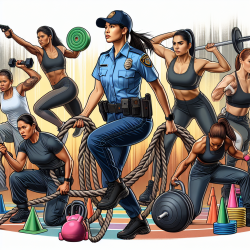In the fast-paced world of law enforcement, physical fitness is not just a requirement; it's a necessity. For female police officers, the ability to quickly change direction while carrying occupational loads can mean the difference between success and failure in critical situations. A recent study sheds light on the relationship between fitness measures and change of direction speed (CODS) in female officers, offering valuable insights for practitioners looking to enhance their skills.
The Importance of Fitness Measures
The research highlights that various fitness measures significantly influence CODS, especially when officers are carrying a 10 kg occupational load. These measures include:
- Lower-body power: Assessed through the standing long jump (SLJ) test.
- Upper-body and trunk muscle endurance: Evaluated using push-up (PU) and sit-up (SU) tests.
- Aerobic power: Estimated via VO2max tests.
The study found that CODS was notably slower when officers were loaded compared to when they were not. This indicates that while unloaded agility performance is strongly associated with loaded performance, the presence of an occupational load significantly impacts mobility.
Enhancing Training Approaches
The findings suggest that practitioners should focus on improving general fitness to enhance CODS performance under load. Here are some practical steps:
- Incorporate resistance training: Strengthen lower-body power through exercises like squats and lunges.
- Focus on endurance: Enhance upper-body and trunk endurance with regular push-up and sit-up routines.
- Aerobic conditioning: Improve aerobic capacity with activities like running or cycling to boost overall fitness levels.
This comprehensive approach not only prepares officers for real-world scenarios but also ensures they can maintain high performance levels even when carrying additional weight.
The Role of Further Research
This study opens the door for further exploration into how specific training regimens can optimize CODS under load. Practitioners are encouraged to delve deeper into research and adapt their training programs based on emerging evidence. By staying informed and continuously improving their methods, they can ensure that female officers are well-equipped to handle the physical demands of their roles.
If you're interested in exploring this topic further, consider accessing the original research paper titled "Associations between Fitness Measures and Change of Direction Speeds with and without Occupational Loads in Female Police Officers" for a detailed understanding of the study's findings and implications.










